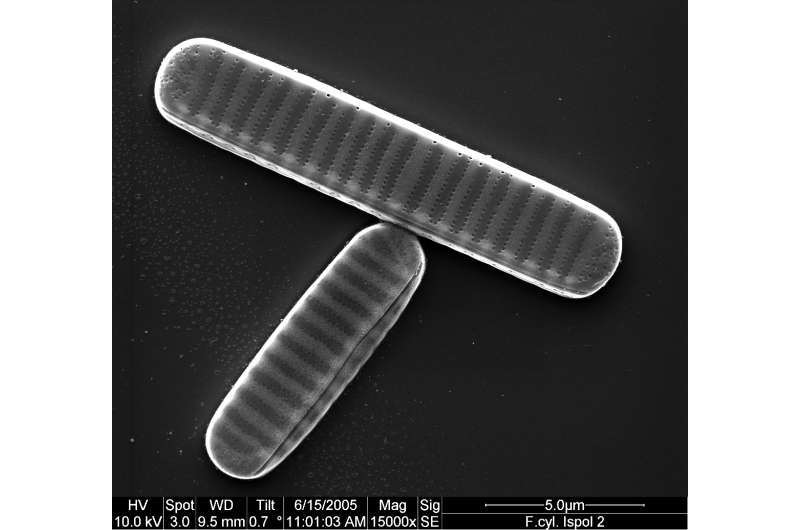Tracking Antarctic adaptations in diatoms

Diatoms are a common type of photosynthetic microorganism, found in many environments from marine to soil; in the oceans, they are responsible for more than a third of the global ocean carbon captured during photosynthesis. This leads to a significant amount of sequestered carbon ending up in the sediments at the bottom of the ocean. In both freshwater and marine ecosystems, the base of the food web is comprised of a diverse community of phytoplankton that includes diatoms who can thrive in a wide range of temperatures. In the Southern or Antarctic Ocean, large populations of a particular diatom, Fragillariopsis cylindrus, dominate the phytoplankton communities.
To learn more about how F. cylindrus adapted to its extremely cold environment, a team led by University of East Anglia (UEA) scientists in Norwich, England conducted a comparative genomic analysis involving three diatoms by tapping expertise from the U.S. Department of Energy Joint Genome Institute (DOE JGI), who conducted all sequencing and annotation. The results, reported online January 16, 2017 in the journal Nature, provided insights into the genome structure and evolution of F. cylindrus, as well as this diatom's role in the Southern Ocean. Of particular interest was that F. cylindrus, which is diploid (it has two copies of each chromosome, thus two versions of each gene) can selectively express the variant best suited to helping it deal with its environment. This provides additional genome-rooted resilience to the organism as its environment changes.
"Many species including phytoplankton are endemic to the Southern Ocean," said Thomas Mock of UEA, who led the study. "They have evolved over millions of years to be able to cope with this extreme and very variable environment. How they did that is largely unknown. Thus our data provide first insights into how these key organisms underpinning one of the largest and unique marine ecosystems on Earth have evolved."
To thrive in the Southern Ocean, F. cylindrus has to be responsive to a wide variety of conditions including darkness, freezing and thawing temperatures, and varying levels of carbon dioxide and iron. For example, like many phytoplankton, F. cylindrus gets trapped with the sea ice in the winter and is released in the summer when most of the sea ice melts.
The 60-million basepair (Megabase or Mb) genome of F. cylindrus was sequenced as part of the DOE JGI's 2007 Community Science Program portfolio. The initial version of genome assembly was available by 2010, analyzing the genome required six more years and multiple groups, including genomicists and population geneticists. For the comparative analysis, its genome was compared against those of the diatoms, Thalassiosira pseudonanana and Phaeodactylum tricornutum, both found in temperate oceans with higher concentrations of dissolved iron. These diatom genomes were previously reported by the DOE JGI.
The analysis revealed nearly a quarter of the F. cylindrus genome contained highly diverged alleles, copies of the same genes found in the other diatoms, but which had diverged by accumulating mutations. The team found that this allelic divergence seems to coincide with the last glacial period, which started some 110,000 years ago. "It was remarkable to find that different alleles of the same genes diverge and evolve to respond to various environmental factors," said Igor Grigoriev, DOE JGI Fungal Genomics head and senior study author.
Mock noted the team also found many genes "unique" to F. cylindrus, such as ice-binding proteins and rhodopsin. He added they observed many proteins with zinc domains, due to the high concentration of zinc in the Southern Ocean, which had not been found in any other phytoplankton genome. The zinc binding protein family appears to have expanded within the last 30 million years.
"Finding that the F. cylindrus population maintains and supports extensive variation in order to provide the adaptive ability of the population under harsh environmental conditions has broad implications for our understanding of natural populations to changing environmental conditions," said Jeremy Schmutz, head of the DOE JGI's Plant Program and a study co-author. "On an individual genotype level, the observed switching of expression from one haplotype copy of the gene to the other haplotype copy under changing conditions demonstrates the complexity of survival mechanisms present in nature for translating available genomic variation and content to environmental response. For most diploid eukaryotic organisms, we have considered the separate haplotypes as largely redundant, and generated a single haplotype reference, but it appears in the case of F. cylindrus the major variation in the two haplotypes is vital to the survival and adaptation of the species and may contain variations in regulatory content. This will likely change the way the genomic techniques and assays are applied by the community to ocean dwelling eukaryotic species."
More information: Evolutionary genomics of the cold-adapted diatom Fragilariopsis cylindrus, Nature, nature.com/articles/doi:10.1038/nature20803
Journal information: Nature
Provided by DOE/Joint Genome Institute





















